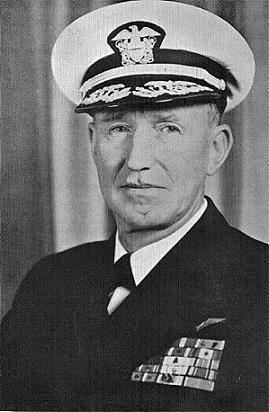Years of service 1917 - 1957 | Name Stuart Ingersoll Rank Vice Admiral | |
 | ||
Battles/wars World War IWorld War IIBattle of the AtlanticPacific WarBattle of the Philippine SeaLeyte Campaign Commands held United States Sixth Fleet, United States Seventh Fleet | ||
Allegiance United States of America | ||
Stuart Howe Ingersoll (June 3, 1898 – January 29, 1983) was a vice admiral of the United States Navy. He was a naval aviator whose career included service as an aircraft carrier commander during World War II and tours as President of the Naval War College and Commandant of Midshipmen at the United States Naval Academy.
Contents

Naval career
Ingersoll was born on 3 June 1898 in Springfield, Massachusetts.
Aboard the carrier Monterey, aircraft in the hangar deck slammed into one another causing fires to break out. Captain Stuart H. Ingersoll was ordered by Admiral William Halsey to abandon ship, but Ingersoll decided to battle the inferno, and he and his men eventually put it out, saving the carrier.
World War II
In the second half of 1941, the U.S. Navy began convoy escort of Allied and neutral shipping in the North Atlantic Ocean west of Iceland, even before the United States entered World War II on 7 December 1941. During this period, Ingersoll was a lieutenant commander and air operations officer on the staff of Rear Admiral Arthur L. Bristol, Jr., who was commander of the U.S. Navy Support Force at Argentia in the Dominion of Newfoundland, the force responsible for the escort work. In March 1942, PBO Hudson patrol aircraft from Argentia sank the first two German submarines (U-boats) sunk by the United States Armed Forces during World War II.
By 1944, Ingersoll was a captain and the commanding officer of the light aircraft carrier USS Monterey (CVL-26), which operated in the Pacific Ocean in the United States Third and Fifth Fleets. He commanded Monterey during the Battle of the Philippine Sea in June 1944 and during the extremely dangerous Typhoon Cobra of December 1944, during which aircraft in Monterey's hangar deck broke loose and wrought destruction as they slid across the deck while the ship rolled heavily, igniting a fire. Urged to abandon ship by United States Third Fleet commander Admiral William F. Halsey, Jr., Ingersoll exhibited determination to save Monterey in ignoring the order as he directed his crew – which included future U.S. President Gerald R. Ford – to extinguish the fire and displayed excellent seamanship in saving the ship. Ingersoll received the Navy Cross for heroism during a Japanese air attack off Formosa.
Postwar
After World War II, Ingersoll served as Commandant of Midshipmen at the United States Naval Academy from 1945 to 1947. Future U.S. President Jimmy Carter was a midshipman at the academy during his tenure. He later served as the commander of the United States Sixth Fleet and from 19 December 1955 to 28 January 1957 was commander of the United States Seventh Fleet, also serving as Commander, United States Taiwan Defense Command, from December 1955 to July 1957.
Ingersoll became the Naval War College's 31st president on 13 August 1957, bringing a broad background in post-World War II planning and leadership in unified commands to the college. During his presidency, he oversaw the changeover of the college's wargaming from manual to computerized processes, and on 13 November 1958, the Naval Electronic Warfare Simulator (NEWS) was commissioned in Sims Hall. He also served on the Civil War Centennial Commission while at the college, beginning in the autumn of 1957. His presidency concluded on 30 June 1960.
Personal life
Ingersoll's first marriage was to the former Josephine Springman (d. 1964), with whom he had a son, Stuart H. "Mike" Ingersoll II, and two daughters, Mary Josephine and Sally Ann. He later married Elinore Dorrance Hill (d. 1977).
Death
Ingersoll died on 29 January 1983 in Newport, Rhode Island.
Navy Cross citation
His official Navy Cross citation reads:
General Orders: Bureau of Naval Personnel Information Bulletin No. 345 (December 1945)Action Date: August 29 - October 30, 1944Name: Stuart Howe IngersollService: NavyRank: CaptainCompany: Commanding OfficerDivision: U.S.S. Monterey (CVL-26)Citation: The President of the United States of America takes pleasure in presenting the Navy Cross to Captain Stuart Howe Ingersoll, United States Navy, for extraordinary heroism and distinguished service in the line of his profession as Commanding Officer of the Light Aircraft Carrier U.S.S. MONTEREY (CVL-26), in the face of tremendous enemy opposition during action against enemy Japanese forces off Formosa during the period 29 August 1944 through 30 October 1944. When the MONTEREY came under heavy Japanese aerial attack while bolding penetrating the hazardous waters off Formosa on 13–14 October, Captain Ingersoll fearlessly held his courage and, hurling the full fighting strength of his planes, despite terrific odds succeeded in blasting a number of hostile aircraft from the sky with no damage to his own vessel. During the Battle for Leyte Gulf on 25–26 October 1944, he inflicted heavy damage and destruction upon capital ships of the Japanese fleet in a bitterly fought, decisive engagement. Captain Ingersoll's inspiring leadership and the valiant devotion to duty of his command contributed in large measure to the outstanding success of these vital missions and reflect great credit upon the United States Naval Service.Ribbon bar
Here is vice admiral Stuart H. Ingersoll´s ribbon bar:
